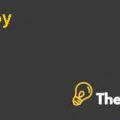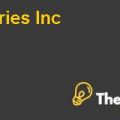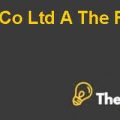
Beta Component:
Beta is the measure of the risk and volatility of stock. It measures the volatility of company’s stock with other stocks in the market. It gives investors an idea whether the price of the security is volatile or not as compare to other securities in the market.
The beta has its own limitations; the future cash flows of the project will be discounted against beta that has been derived from historical data, which may not always be suitable enough because the environment continuously changes and there is a possibility that the past may not continue in future.
The beta of the Heinz represents 0.62 whereas for Kraft, Campbell and Del Monte represent 0.58, 0.32 and 0.72 respectively. Beta is directly proportional to risk, higher the beta, higher the risk, so the Heinz is a medium-sized risk bearer as compare to other companies in the industry whereas Campbell is the lowest bearing company in the industry, so a comparison of Campbell with Heinz may not be justifiable. The case itself presents the information about beta of H.J. Heinz and other competitors which are used in our analysis in calculating WACC.
Risk Free Rate and Market Premium:
Risk free rate is the return on securities that a company can enjoy without bearing any risk and are relatively low in nature as compare to other market returns. For the evaluation of the future projects, the companies usually took return on Government bonds and Government securities i.e.: T bills as a risk free rate whereas the market premium is the difference of the market risk and risk free rate.
The risk free rate used in our analysis in determining WACC of Heinz and its other comparable companies are 4.05% and 4.53% for 2009 and 2010 respectively. The rates are based on 30 years Government bonds which is assumed to be highest rate bond, rating on conservative basis. The Market premium has been calculated by taking an average of premium on long-term and short-term periods.
Taxation:
Tax is an important factor to consider in WACC calculation. The interest expense is an allowable expense in calculating taxable profits whereas, dividends are not an allowable expense in calculating profits, so in order to facilitate better calculation of WACC, cost of debt is calculated after taking the effect of tax. Our analysis in appendices considers an average of tax charged in previous years.
Cash Flow Projections:
Projected cash flows play an important role when evaluating any project. Sometimes, it is not always easy to project cash flows of the project because of the complexity of market and the environment is subject to continuous change. So in order to facilitate better decision-making, the management shall adopt its best estimate to project the cash flows.
The projected cash flows are based on reasonable assumptions and are expected to be realized in future. This could be achieved through exercising an evaluation based on past results or a market survey can also be adopted to predict cash flows.
If the management fails to predict the cash flows reasonably, then it could substantially threaten the decision of the management because the future cash flows are the key drivers in calculating net present value. If the management takes decision on the basis of uncertain cash flows, then it will undervalue the worth of shareholders.
WACC of H.J. Heinz
Our analysis in appendices 1 and 2 shows results that the company has WACC of 6.76% and 7.51% in 2009 and 2010 respectively. It has been increased from last year which indicates that the company is bearing an additional cost to entertain their debt and common shareholders. Heinz could use this discount rate to evaluate the potential performance of new products. Different assumptions have been carried out in order to determine WACC and are determined below;
- Risk free rate has been assumed on 30 years Government bonds, assumed to be highest bond rating on conservative basis.
- Market premium is assumed as an average of risk premium on short and long-term period.
- Market value of equity is calculated by multiplying the share price at the end of fiscal year with outstanding shares.
- Book value of debt is assumed to be equal to market value.
- Tax rate is assumed as an average of prior years...............................
This is just a sample partial case solution. Please place the order on the website to order your own originally done case solution.










